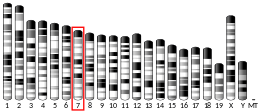NLRP10
NLRP10, short for NOD-like receptor family pyrin domain containing 10, is an intracellular protein of mammals that functions in apoptosis and the immune system. It is also known as NALP10, NOD8, PAN5, Pynod, and CLR11.1, and is one of 14 pyrin domain containing members of the NOD-like receptor family of cytoplasmic receptors, although it differs from other NOD-like receptors by lacking the characteristic leucine-rich repeat domain. It is also believed that it helps regulate the inflammatory response. NLRP8 reduces inflammatory and innate immune responses by inhibiting the activity of two proteins associated with the inflammasome; caspase-1 and PYCARD.[5][6]
References
- ENSG00000281166, ENSG00000182261 GRCh38: Ensembl release 89: ENSG00000276780, ENSG00000281166, ENSG00000182261 - Ensembl, May 2017
- GRCm38: Ensembl release 89: ENSMUSG00000049709 - Ensembl, May 2017
- "Human PubMed Reference:". National Center for Biotechnology Information, U.S. National Library of Medicine.
- "Mouse PubMed Reference:". National Center for Biotechnology Information, U.S. National Library of Medicine.
- Wang Y, Hasegawa M, Imamura R, et al. (June 2004). "PYNOD, a novel Apaf-1/CED4-like protein is an inhibitor of ASC and caspase-1". Int. Immunol. 16 (6): 777–86. doi:10.1093/intimm/dxh081. PMID 15096476.
- Imamura R, Wang Y, Kinoshita T, et al. (May 2010). "Anti-inflammatory activity of PYNOD and its mechanism in humans and mice". J. Immunol. 184 (10): 5874–84. doi:10.4049/jimmunol.0900779. PMID 20393137.
Further reading
- Wang Y, Hasegawa M, Imamura R, et al. (2004). "PYNOD, a novel Apaf-1/CED4-like protein is an inhibitor of ASC and caspase-1". Int. Immunol. 16 (6): 777–86. doi:10.1093/intimm/dxh081. PMID 15096476.
- Kinoshita T, Wang Y, Hasegawa M, et al. (2005). "PYPAF3, a PYRIN-containing APAF-1-like protein, is a feedback regulator of caspase-1-dependent interleukin-1beta secretion". J. Biol. Chem. 280 (23): 21720–5. doi:10.1074/jbc.M410057200. PMID 15817483.
- Inohara N, Nuñez G (2003). "NODs: intracellular proteins involved in inflammation and apoptosis". Nat. Rev. Immunol. 3 (5): 371–82. doi:10.1038/nri1086. PMID 12766759.
- Strausberg RL, Feingold EA, Grouse LH, et al. (2002). "Generation and initial analysis of more than 15,000 full-length human and mouse cDNA sequences". Proc. Natl. Acad. Sci. U.S.A. 99 (26): 16899–903. doi:10.1073/pnas.242603899. PMC 139241. PMID 12477932.
- Tschopp J, Martinon F, Burns K (2003). "NALPs: a novel protein family involved in inflammation". Nat. Rev. Mol. Cell Biol. 4 (2): 95–104. doi:10.1038/nrm1019. PMID 12563287.
- Gerhard DS, Wagner L, Feingold EA, et al. (2004). "The status, quality, and expansion of the NIH full-length cDNA project: the Mammalian Gene Collection (MGC)". Genome Res. 14 (10B): 2121–7. doi:10.1101/gr.2596504. PMC 528928. PMID 15489334.
- Ha HJ, Kim DS, Hahn Y (2009). "A 2.7-kb deletion in the human NLRP10 gene exon 2 occurred after the human-chimpanzee divergence". Biochem. Genet. 47 (9–10): 665–70. doi:10.1007/s10528-009-9262-2. PMID 19544093.
This article is issued from Wikipedia. The text is licensed under Creative Commons - Attribution - Sharealike. Additional terms may apply for the media files.



